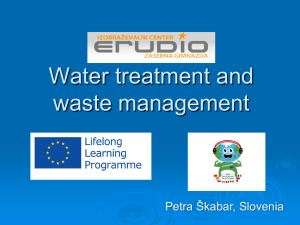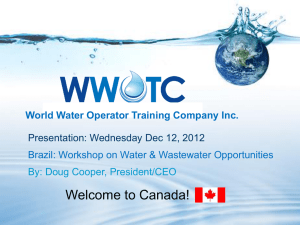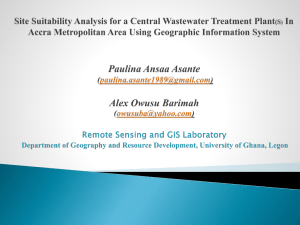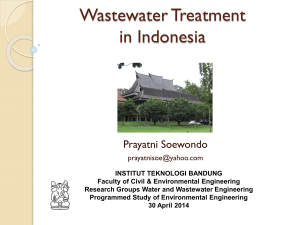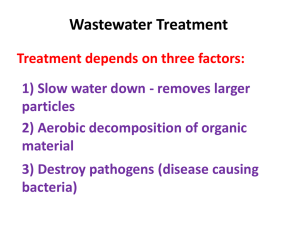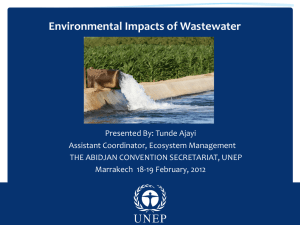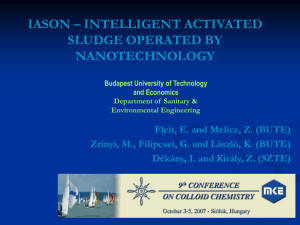waste water treatment - St. Francis Xavier Church , Panvel
advertisement
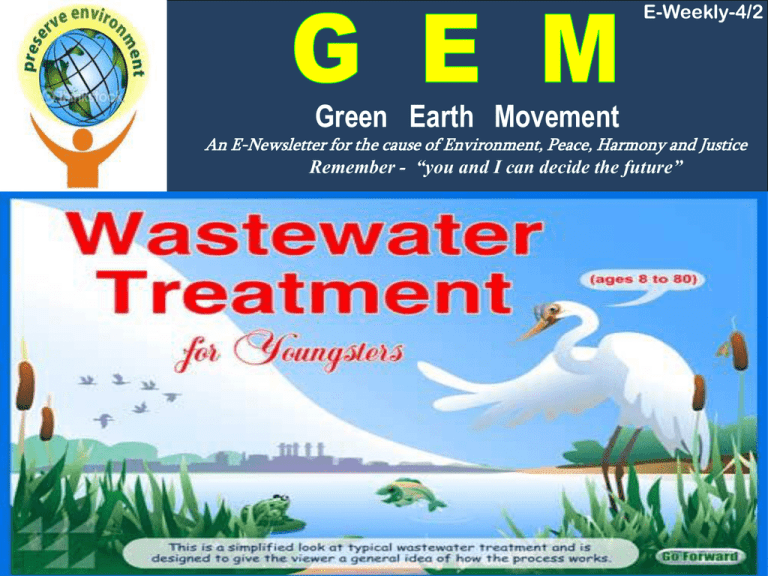
E-Weekly-4/2 Green Earth Movement An E-Newsletter for the cause of Environment, Peace, Harmony and Justice Remember - “you and I can decide the future” The term "wastewater treatment" is also called "sewage treatment." Nature has an amazing ability to cope with small amounts of water wastes and pollution, but it would be overwhelmed if we didn't treat the billions of gallons of wastewater and sewage produced every day before releasing it back to the environment. Treatment plants reduce pollutants in wastewater to a level nature can handle. Wastewater is used water. It includes substances such as human waste, food scraps, oils, soaps and chemicals. In homes, this includes water from sinks, showers, bathtubs, toilets, washing machines and dishwashers. Businesses and industries also contribute their share of used water that must be cleaned. Wastewater also includes storm runoff. Although some people assume that the rain that runs down the street during a storm is fairly clean, it isn't. Harmful substances that wash off roads, parking lots, and rooftops can harm our rivers and lakes. Why Treat Wastewater? It's a matter of caring for our environment and for our own health. There are a lot of good reasons why keeping our water clean is an important priority: 1. Fisheries Clean water is critical to plants and animals that live in water. This is important to the fishing industry, sport fishing enthusiasts, and future generations. Wildlife habitats Our rivers and ocean waters teem with life that depends on shoreline, beaches and marshes. They are critical habitats for hundreds of species of fish and other aquatic life. Migratory water birds use the areas for resting and feeding. Recreation and quality of life Water is a great playground for us all. The scenic and recreational values of our waters are reasons many people choose to live where they do. Visitors are drawn to water activities such as swimming, fishing, boating and picnicking. Health concerns If it is not properly cleaned, water can carry disease. Since we live, work and play so close to water, harmful bacteria have to be removed to make water safe. Effects of wastewater pollutants If wastewater is not properly treated, then the environment and human health can be negatively impacted. These impacts can include harm to fish and wildlife populations, oxygen depletion, beach closures and other restrictions on recreational water use, restrictions on fish and shellfish harvesting and contamination of drinking water. Environment Canada provides some examples of pollutants that can be found in wastewater and the potentially harmful effects these substances can have on ecosystems and human health: Decaying organic matter and debris can use up the dissolved oxygen in a lake so fish and other aquatic biota cannot survive; Excessive nutrients, such as phosphorus and nitrogen (including ammonia), can cause eutrophication, or overfertilization of receiving waters, which can be toxic to aquatic organisms, promote excessive plant growth, reduce available oxygen, harm spawning grounds, alter habitat and lead to a decline in certain species; Chlorine compounds and inorganic chloramines can be toxic to aquatic invertebrates, algae and fish; Bacteria, viruses and disease-causing pathogens can pollute beaches and contaminate shellfish populations, leading to restrictions on human recreation, drinking water consumption and shellfish consumption; Metals, such as mercury, lead, cadmium, chromium and arsenic can have acute and chronic toxic effects on species. Other substances such as some pharmaceutical and personal care products, primarily entering the environment in wastewater effluents, may also pose threats to human health, aquatic life and wildlife. PROCES OF WASTE WATER TREATMENT Sewage treatment generally involves three stages, called primary, secondary and tertiary treatment. 1] Primary treatment consists of temporarily holding the sewage in a quiescent basin where heavy solids can settle to the bottom while oil, grease and lighter solids float to the surface. The settled and floating materials are removed and the remaining liquid may be discharged or subjected to secondary treatment. 2] Secondary treatment removes dissolved and suspended biological matter. Secondary treatment is typically performed by indiginous, water-borne microorganisms in a managed habitat. Secondary treatment may require a separation process to remove the microorganisms from the treated water prior to discharge or tertiary treatment. Disinfection is considered part of secondary treatment of wastewater. This can be accomplished through chemical, ultraviolet light or ozone processes. The most common way to disinfect water at this stage is to use chlorine. Disinfection inactivates biological contaminants in the wastewater prior to discharge of the water back into the environment. The sludge that is removed from primary and secondary treatment processes must also be treated prior to being disposed. As for the water, look carefully at what is discharged from the plant and consider all of the ways it has been treated – physically, biologically and chemically – and you will be amazed at the clean, clear water that is produced. For the past 40 years, the Clean Water Act has regulated these processes to protect the environment and the public’s health. The act, along with other federal and state regulations, ensures that we can use this water again. After all, the wastewater that is treated will be used again by the planet and eventually our bodies. 3] Tertiary treatment is sometimes defined as anything more than primary and secondary treatment in order to allow rejection into a highly sensitive or fragile ecosystem (estuaries, low-flow rivers, coral reefs,...). Treated water is sometimes disinfected chemically or physically (for example, by lagoons and microfiltration) prior to discharge into a stream, river, bay, lagoon or wetland, or it can be used for the irrigation of a golf course, green way or park. If it is sufficiently clean, it can also be used for groundwater recharge or agricultural purposes. BENEFITS OF WASTE WATER TREATMENT 1] Clean Water Water is a renewable resource because it gets purified through evaporation and rain; however, only about 3 percent of the earth's water is potable. Although nature slowly cleans wastewater over time, the main benefit of wastewater treatment is maintaining clean water for reuse. 2] New Research and Improvements Wastewater treatment processes are changing as researchers develop new techniques. Such research leads to improvements in purification, the speed of water treatment and uses for the waste products removed. Development of new processes also saves more energy, time and resources, which are then available for other needs. 3] Disease Wastewater treatment processes can contain and remove potential disease-causing contaminants through a filtering system that blocks their path and further treatment that kills harmful organisms. This keeps potential diseases and bacteria from entering other water sources, or the ground, and harming people as well as plants and animals. Treatment systems continue to develop better methods of purifying the water. 4] Economics Jobs are created by wastewater treatment research and processing. Treatment facilities, for example, require regular maintenance and human operation. In addition, returning clean water to rivers and streams helps maintain natural areas, encouraging tourism. LIST OF SOME OF THE WASTE WATER CONSULTANTS (Courtesy: Internet. List not exhaustive) Ahmedabad: FREEION ENGINEERING, 06 Nutan Prakash Park, Chandkheda Sabermati, Ioc Road, D Cabin, Ahmedabad – 380019, 9374574187, 9601403700, 9601403011 Bangalore: LIFE GUARD SALES AND SERVICES: No.6, 1st Flr, Opp Bajaj Showroom, Old Madras Rd, Subhash Ngr, Virgonagar, Post, Krishnarajapuram, Bangalore – 560036, (080) 66497377 Delhi: Fontus Water Limited, A-1/152, In Front Of Shiv Mandir, Ignou Rd, Okhla Industrial Area, Delhi – 110020, Tel: (011) 66226138 Goa: ESTEEM HYDRO SYSTEM PVT LTD, 21-A, Jalvayu Villa, Near MES College, Jaikisan Club Road, Zuarinagar, GOA – 403726,9545505238, 9765370572, (0832) 3293065 Gurgaon: DR GHOSH LABORATORIES, 113/16 Prem Nagar, Near Sohna Chowk, Old Jail Road, Gurgaon, Gurgaon - 122001 | (011) 66223780 Mumbai: 1] FILTRA CONSULTANTS AND ENGINEERS, 109, Shiv Sagar Industrial Estate, Opp Aarey Road, Kotkar Road, Goregaon East, Mumbai – 400063, (022) 29275907, 29271998, 29275924, 28712027 2] THERMAX LIMITED, Dhanraj Mahal,2nd Floor, Near Gateway Of India, Chatrapati Shivaji Marg, Colaba, Mumbai – 400005, 9823261916 , (022) 22045391, 22852058 Secunderabad: PURE & PRISTINE SOLUTIONS: Plot No. 52/1, H.No 8/7/178/28 Swarnadhama Nagar, Old Bowenpally, Secundrabad - 500011, India, +(91)-8790998491 This educational PowerPoint Presentation is prepared by GEM Team (courtesy: internet). For other similar GEM PowerPoint Presentations on various environmental issues see next.. Zero Garbage Solar Energy (Darkness to Light) Junk Food Twenty Tips To Save Nature Plastic – a boon or bane? Green Passion Soft drink – A Health Hazard Waste to energy Rain Water Harvesting Eco-friendly Religions Happy Green Diwali Climate Change The future of Biodiversity Genetically Modified Foods Waste Water Treatment These PPTs may be downloaded from our website: www.stfrancisxavierpanvel.in – GEM section


